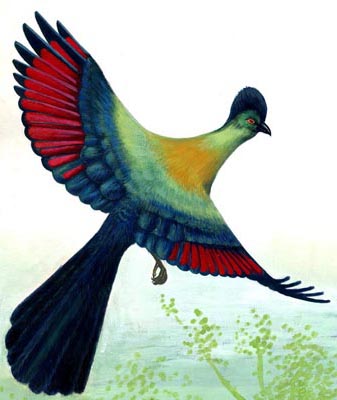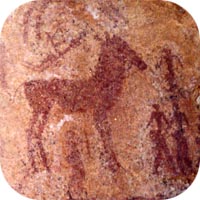The ENTC now has a new website, at www.entc.org.sz
Our logo is adapted from a painting by Phillip Dlamini, 1998, of a purple crested turaco. In traditional Swazi dress, the red feathers feature in the royal headdress, so this bird illustration is not only a symbol for wildlife conservation, but also of cultural heritage.


(Last update by Bob Forrester, December 2005)
Rock paintings attributed th the San (also known as Bushmen) have been identified by the ENTC in many parts of Eswatini, but predominantly in the western highveld granite areas. The paintings are similar in subject matter, style and colouring to the rock art of the Drakensburg and Lesotho.
The Nsangwini Rock Art Shelter is the largest in the country and is one of two sites open to the public. The shelter is currently being upgraded for visitors. A floor has been installed, access improved and guides are being trained. All profits from the project will be put back into the community to help support AIDS orphans.
The Sandlane Rock Paintings are about 1 km from the Sandlane border post. There is a signpost about a hundred meters on the Swazi side of the border that shows which road to go down. The dirt road passes through a homestead belonging to the Mntjali family. The site is a few metres beyond the huts. The paintings are in reasonably good condition. Mrs Mntjali looks after them on a voluntary basis.
The paintings usually depict animals, people, hunting parties, battle scenes and dances.
A video documentary, funded by UNESCO, documented some of the better known rock art sites.
The following extracts are taken from "The Archaeology of Swaziland, an Introduction" by John Masson, and from information provided by John Masson. The book was published in 2011 and is available from Websters in Eswatini.
With a single exception, the rock art of Eswatini belongs to the Bushman tradition of expressing cultural beliefs and rituals as paintings on the walls of rock shelters and, occasionally, on free standing rock faces. They also engraved on stone, but their engravings are usually found in the western drier parts of southern Africa, and none have so far been recorded in Swaziland.
This site was one of the first to be located, in 1958. Although it was not realised at the time, it contained more diversity of subject matter than any found subsequently. There was one feature which even at that time was thought to be unusual, namely two winged figures in dark red monochrome which stood out because of their clarity of detail on a panel separated by a crack in the rock from the rest of the painting surface.

Apart from being a probable rain making centre the Nsangwini paintings have other special features. The shelter has no paintings of eland, but it does have blue Wildebeest which are unique in Eswatini paintings, and which are entirely absent in the great Drakensberg array of Bushman art. There are two blue Wildebeest with an elongated human figure between them. Low down in the panel is another wildebeest which appears to be emerging from a crack in the rock. The only other animals with which these Wildebeest might conceivably be confused are the black wildebeest and the buffalo, but the former has distinctively curved horns, while the latter has a much heavier body and head with a horned boss. From the set of their heads and their body profiles they are undoubtedly Wildebeest. They may represent ancestral spirits, special to the people associated with this rock shelter.

Another figure of note at Nsangwini, regrettably now very faint, but clearly identifiable in the late 1950sí photographs is a dancing figure low down on the painted rock face. In those days it was referred to, facetiously, as "the Can-Can Dancer". Today it is possible to be more discriminating, by recognizing an important ingredient in Bushman paintings, namely gender symbolism. One recurring image is that of the "Mythic Woman", which appears in various forms, but unmistakably depicts the reproductive posture - raised arms, spread legs and genital emission. The Nsangwini figure though faded may be sufficiently diagnostic to bring it broadly within this category of paintings. It may on the other hand relate to creation mythology, or to some other as yet unknown aspect of sexuality and reproduction in Bushman mythology.

There is an unusual group of black figures on the "ceiling" of the shelter. They had been recorded in 1958 but their possible significance had not been appreciated at that time. They comprised what seemed to be a red monochrome rain-animal, apparently being surrounded by four tall black figures outlined in red, and with bird or lizard-like heads. Above these figures are two animals in black, also outlined in red, which resemble fat-tailed sheep. The red rain-animal is similar to the one at the Komati Pool Site except that it has recognisable ears. The black figures and the rain-animal may represent a single composition.

The winged figures at Nsangwini are surmounted by four human figures, also in dark red monochrome which are a more familiar motif in southern African rock art. These are carrying bundles which at a site in Lesotho were described by Vinnicombe as buchu, a well known aromatic herb. This grouping is in fact repeated in another smaller setting elsewhere in the Nsangwini shelter. They could be shaman initiates moving towards the crack in the rock face, the significance of which is marked by the two winged figures who could be transformed shamans indicating the entrance to the spirit world behind the rock face.

The paintings are faded because of the number of visitors who have thrown water over them to make them clearer for photographing. The senior woman of the homestead used to provide and apply the water. When they were first photographed in 1958 there was a dark red 'sunburst' about 5 cms in diameter at the junction of the two panels, but this has since disappeared.
There are both animal and human figures in dark red monochrome. The former are a variety of small to medium sized buck, including vaal rhebok or other smaller buck, facing in both directions.

At Sandlane Rock there is an animal which the Swazi homesteads nearby identify as a "donkey". Just below it is another "donkey" with an exfoliated head. Both animals are so placed in a surrounding group of small antelope and a typical line of human figures, all in the familiar dark red monochrome, that they cannot be donkeys in this context. It is possible that they are zebra or perhaps quagga, which do not appear in the Bushman folktales reflected in the paintings, and their presence here may be one of those unique features of Eswatini paintings, like the blue Wildebeest at Nsangwini, which do not figure in South African rock art, or in the mythology of the Bushmen as yet recorded.
There are numerous human figures, but apart from the 'males in procession' they are not easy to identify. These have a definite symbolic content, representing a trance or initiation dance.
Our Contacts:
Head Quarters: (+268) 2416 1489/1179
Email: info@sntc.org.sz
King Sobhuza II Park: (+268) 2416 1489/1179
Email: ksmp@sntc.org.sz
National Museum: (+268) 2416 1489/1179
Email: curator@sntc.org.sz
Copyright © ESWATINI NATIONAL TRUST COMMISSION
Malolotja Nature Reserve: (+268) 2444 3241 / (+268) 2416 1480
Email: culturalvillage@sntc.org.sz
Mantenga Nature Reserve and Swati Cultural Village: 2416 1151/1178
Email: culturalvillage@sntc.org.sz
Mlawula Nature Reserve: (+268) 2383 8885 (Reception)
(+268) 2383 8453 (Senior Warden)
Email: culturalvillage@sntc.org.sz
Magadzavane Lodge: (+268) 2343 5108/9
Email: magadzavane@sntc.org.sz